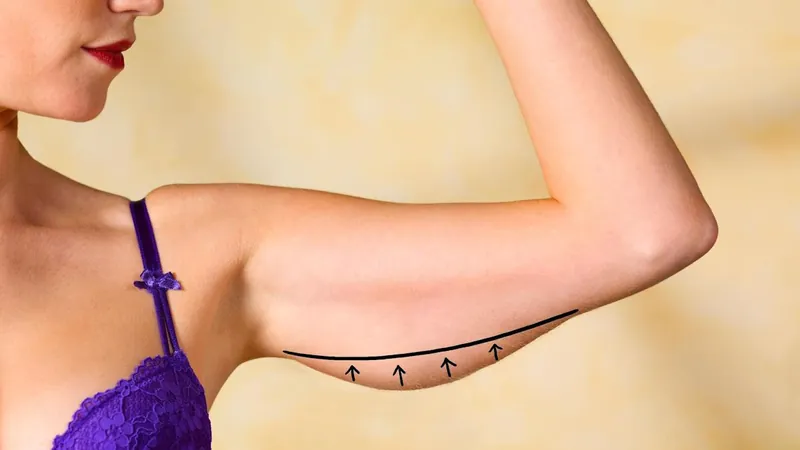
Surge in Cosmetic Surgery in the UK: What's Driving the Transformation?
2025-04-05
Author: Olivia
The landscape of cosmetic surgery in the UK is undergoing a significant transformation, driven largely by a growing desire for aesthetic enhancement and body positivity. According to recent figures from private clinics, 2024 saw a remarkable increase in surgical procedures, with a total of 27,462 operations performed - marking a 5% rise from the previous year. A staggering 90% of these procedures were conducted on women.
Interestingly, breast augmentation continues to reign supreme as the most sought-after cosmetic procedure, closely followed by breast reductions. However, the surge in popularity of facial rejuvenation options—such as face and brow lifts—alongside body contouring techniques like liposuction and tummy tucks is reshaping the priorities of patients, as reported by the British Association of Aesthetic Plastic Surgeons (BAAPS).
The BAAPS president has attributed the rise to not only decreasing costs and increased accessibility but also a notable shift in societal attitudes towards cosmetic surgery. With many individuals now perceiving these enhancements as a normalized aspect of self-care, more patients feel empowered to seek procedures.
Key statistics highlight this trend: face and neck lifts jumped by 8% in 2024 compared to 2023, while brow lifts surged by an impressive 20%. Eyelid surgery, or blepharoplasty, saw a 13% increase, surpassing tummy tucks to rank as the third most common surgery.
Body contouring procedures are also witnessing significant growth, with liposuction increasing by 8%—totaling 2,623 procedures in 2024. Thigh lifts skyrocketed by 24%, whereas brachioplasty, aimed at eliminating 'bingo wings', rose by 13%, with figures showing a leap from 389 to 439 procedures.
In addition to surgical options, non-invasive treatments like Botox and fillers remain incredibly popular, with nearly 10,000 performed by BAAPS members in 2024. Despite the overall growth, certain specialized procedures like labiaplasty have faced declines, decreasing by 7% in the same timeframe.
Nugent of BAAPS emphasizes the newfound accessibility of cosmetic surgery, stating, “While the treatments are still expensive, they’ve become more affordable overall.” This transformation aligns with societal movements toward self-care and wellness over the past decade, normalizing cosmetic enhancements and reducing associated stigma.
Part of the increase in surgical interventions can also be traced back to individuals transitioning from non-surgical enhancements. As patients grow weary of frequent visits for fillers and Botox, many opt for surgical solutions to achieve more long-lasting results. Moreover, the rise of weight-loss injections such as Ozempic, Wegovy, and Mounjaro has spurred additional interest in cosmetic surgery, particularly among those experiencing changes in facial volume due to weight loss.
Statistics regarding post-weight-loss procedures are not directly recorded by BAAPS, yet Nugent notes an uptick in patients undergoing surgery following such treatments, suggesting a notable trend where individuals seek to address sagging skin or facial deflation after weight loss.
The increasing normalization of cosmetic surgery has made it less of a taboo, according to patients like 33-year-old Kirsten White from Sheffield, who underwent a breast reduction and uplift after significant weight loss. She reflects, "There’s less stigma now. People are supportive of decisions that enhance your happiness."
Men are also increasingly partaking in the cosmetic surgery wave, though they still make up a smaller percentage of total procedures. In 2024, 1,799 men underwent surgeries—a slight drop from the previous year, comprising only 6.6% of the total surgeries recorded. Rhinoplasty continues to be the leading choice among men, despite a decline in numbers, alongside a notable 26% increase in face and neck lifts.
Societal perceptions and platform influences like social media play a crucial role in shaping attitudes toward aesthetics. Dr. Beth Daniels from the Centre for Appearance Research highlights that the pandemic-induced rise of video calls exacerbated self-awareness regarding appearances. As she puts it, “The value placed on youth can compel women to consider cosmetic procedures, leading to feelings of invisibility as they age.”
Moreover, Anthony Macquillan, vice president of BAAPS, links the surge in facelifts to varied societal changes, including the rise in pension age, suggesting that these procedures go beyond aesthetics—they also serve functional purposes that bolster confidence in personal and professional environments.
It's essential to note that BAAPS data is derived from a sample of 233 members and does not encompass all cosmetic surgeries performed in the UK, particularly those by non-BAAPS affiliated surgeons or carried out overseas, where cost-effective options attract many Brits seeking treatment abroad.
However, potential patients must exercise caution; cosmetic procedures carry inherent risks. The NHS warns of possible complications and advises thorough research, especially regarding the credibility of clinics and the nature of risks involved in specific surgeries. As Professor Jim Frame asserts, "A significant number of individuals may regret their cosmetic surgeries, indicating the importance of informed decision-making."
As the UK witnesses rising numbers in cosmetic surgeries, it's clear that societal attitudes are shifting, but along with progress comes the responsibility of ensuring safety and accountability in these transformative choices.









 Brasil (PT)
Brasil (PT)
 Canada (EN)
Canada (EN)
 Chile (ES)
Chile (ES)
 Česko (CS)
Česko (CS)
 대한민국 (KO)
대한민국 (KO)
 España (ES)
España (ES)
 France (FR)
France (FR)
 Hong Kong (EN)
Hong Kong (EN)
 Italia (IT)
Italia (IT)
 日本 (JA)
日本 (JA)
 Magyarország (HU)
Magyarország (HU)
 Norge (NO)
Norge (NO)
 Polska (PL)
Polska (PL)
 Schweiz (DE)
Schweiz (DE)
 Singapore (EN)
Singapore (EN)
 Sverige (SV)
Sverige (SV)
 Suomi (FI)
Suomi (FI)
 Türkiye (TR)
Türkiye (TR)
 الإمارات العربية المتحدة (AR)
الإمارات العربية المتحدة (AR)